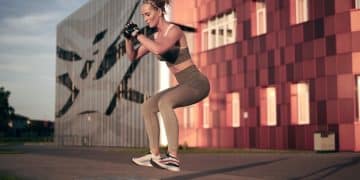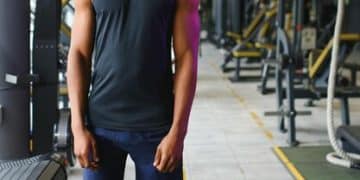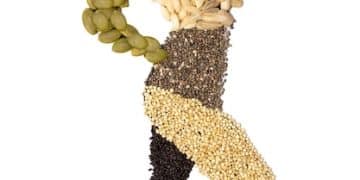Keto Bodybuilding Nutrition: Is It Possible? Plan with 50g Carbs
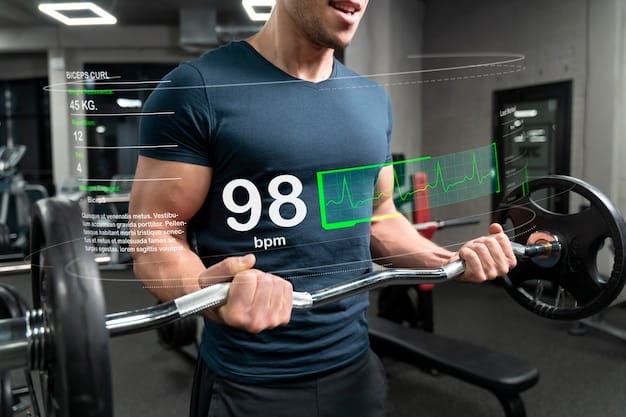
The possibility of combining ketogenic nutrition with competitive bodybuilding, an approach known as Keto Bodybuilding Nutrition: Is It Possible? A Sample Plan with 50 Grams of Carbs, has gained traction among athletes seeking enhanced fat loss and sustained energy, often leveraging a targeted carbohydrate intake for performance benefits.
The pursuit of peak physical condition often drives athletes to explore diverse nutritional strategies. For those navigating the demanding world of competitive bodybuilding, the question arises: is it truly feasible to combine the principles of a ketogenic diet with the intense requirements of muscle growth and athletic performance? We delve into whether Keto Bodybuilding Nutrition: Is It Possible? A Sample Plan with 50 Grams of Carbs offers a viable path for achieving both leanness and muscle mass.
The Science Behind Ketogenic Diets for Athletes
Ketogenic diets, characterized by very low carbohydrate intake, moderate protein, and high fat, fundamentally alter the body’s primary fuel source from glucose to ketones. For athletes, particularly bodybuilders, this metabolic shift presents both intriguing possibilities and unique challenges. Understanding how the body adapts to ketosis is crucial for evaluating its effectiveness in a high-demand athletic context.
When carbohydrate intake is severely restricted, typically below 50 grams per day, the liver begins to produce ketone bodies from fat. These ketones, namely beta-hydroxybutyrate (BHB), acetoacetate, and acetone, can then be used by the brain, muscles, and other tissues for energy. This state, known as nutritional ketosis, is distinct from ketoacidosis, a dangerous condition primarily seen in uncontrolled type 1 diabetes.
Metabolic Adaptations and Muscle Preservation
One of the primary concerns for bodybuilders considering a ketogenic diet is muscle preservation. Traditional bodybuilding dogma emphasizes high carbohydrate intake to fuel workouts and replenish glycogen stores, preventing muscle catabolism. However, research suggests that a well-formulated ketogenic diet can be surprisingly muscle-sparing.
- Reduced Protein Breakdown: In a ketogenic state, the body becomes more efficient at using fat for energy, which can spare protein from being catabolized for gluconeogenesis.
- Enhanced Fat Oxidation: Athletes adapted to burning fat for fuel can tap into virtually unlimited fat reserves during exercise, potentially delaying fatigue and improving endurance.
- Ketone Body as Fuel: Ketone bodies themselves can serve as a direct fuel source for muscle tissue, especially during prolonged, low to moderate intensity exercise.
Moreover, the hormonal milieu shifts during ketosis. Insulin levels are significantly lower, which can promote fat burning, while growth hormone and IGF-1 levels might be influenced in ways that can be beneficial for athletes depending on the specific protocol. The metabolic flexibility gained from keto-adaptation allows the body to seamlessly switch between fat and ketone utilization, a key advantage for sustained energy levels.
Navigating the initial phase of keto-adaptation, often referred to as the “keto flu,” can be challenging. Symptoms like fatigue, headaches, and irritability are common as the body transitions. Adequate electrolyte intake (sodium, potassium, magnesium) is paramount during this period to mitigate these effects. For a bodybuilder, pushing through this phase while maintaining training intensity requires careful planning and a disciplined approach.
Ultimately, the science suggests that while challenging, the metabolic adaptations inherent in a ketogenic diet could offer benefits for bodybuilders, particularly in terms of body composition and sustained energy. The key lies in strategic implementation and understanding the nuances of how the body behaves when carbohydrates are limited.
Customizing Keto: The 50-Gram Carb Approach for Bodybuilders
While strict ketogenic diets typically advise carbohydrate intake below 20-30 grams, a flexible approach that allows for up to 50 grams of net carbs daily can be particularly advantageous for bodybuilders. This slightly higher carb allowance offers greater dietary flexibility and can be strategically used to fuel intense training sessions or promote anabolic processes without fully knocking the body out of ketosis.
This “targeted ketogenic diet” (TKD) or “cyclical ketogenic diet” (CKD) variation acknowledges that a bodybuilder’s energy demands often exceed what can be efficiently fueled by fat and ketones alone, especially during heavy lifting. The judicious inclusion of carbohydrates can provide the necessary glucose for high-intensity, glycolytic activities while largely maintaining the fat-burning benefits of ketosis.
Strategic Carb Timing for Performance
The success of the 50-gram carb approach hinges on timing. Instead of spreading these carbohydrates evenly throughout the day, bodybuilders using this method often concentrate their carb intake around their workouts. This strategy aims to replenish some glycogen stores and provide readily available glucose for maximal effort.
- Pre-Workout: Consuming a portion of the 50 grams (e.g., 20-30g) as easily digestible carbohydrates (e.g., a small piece of fruit, a rice cake) 30-60 minutes before training can significantly boost performance and delay fatigue during intense sets. This provides a quick energy source without disrupting ketosis for extended periods.
- Post-Workout: The remaining carbohydrates can be consumed immediately after training to aid in glycogen replenishment and muscle recovery. This “anabolic window” allows for efficient uptake of glucose into muscle cells, kickstarting the recovery process.
- Sources of Carbs: Emphasis should be placed on nutrient-dense, whole food sources of carbohydrates, even within the 50-gram limit. Think berries, leafy greens, small portions of starchy vegetables, or specific low-glycemic fruits. Avoiding refined sugars and highly processed carb sources is crucial.

Beyond workout timing, the quality of carbohydrates matters immensely. Fibrous vegetables, which contribute to satiety and micronutrient intake, are always encouraged. Even with a 50-gram limit, it’s possible to incorporate a good volume of vegetables that provide essential vitamins and minerals without significantly impacting ketosis. Understanding one’s own body and its responses to different carbohydrate sources is key to fine-tuning this approach.
This flexible carb allowance also makes social situations and dietary adherence easier. The rigidity of a very strict keto plan can be a barrier for many; allowing for a slightly higher carb threshold can enhance long-term compliance, which is vital for any sustained dietary strategy in bodybuilding. Patience and observation are important to determine optimal timing and carb sources for individual responses.
In essence, the 50-gram carb framework provides a strategic middle ground, enabling bodybuilders to leverage the fat-burning benefits of ketosis while still providing critical fuel for high-intensity training and recovery. It requires careful planning and a deep understanding of one’s own metabolic responses, but it can be a powerful tool for body composition.
Essential Macronutrient Ratios for Keto Bodybuilding
Mastering macronutrient ratios is the cornerstone of any successful bodybuilding nutrition plan, and this holds especially true for a ketogenic approach. Unlike conventional diets, where carbohydrates often dominate, keto bodybuilding flips this paradigm, shifting reliance to fats and proteins while maintaining a strict carb ceiling. Understanding and adhering to these ratios is paramount for achieving and maintaining ketosis while supporting muscle growth and recovery.
For a ketogenic diet tailored to bodybuilding, the typical macro distribution aims for:
- Fats: 60-75% of total daily calories
- Protein: 20-35% of total daily calories
- Carbohydrates: 5-10% of total daily calories (capped at 50 grams net)
These percentages are a guideline and may need slight adjustments based on individual body composition, activity level, and specific goals (e.g., bulking vs. cutting). The key is to ensure fat intake is sufficiently high to facilitate ketone production, while protein intake is optimized to support muscle maintenance and growth without being so high that it encourages gluconeogenesis excessively.
Targeting Protein Intake for Muscle Growth
Protein is the building block of muscle, and its importance is amplified in a bodybuilding context. While some concern exists that high protein on keto could kick one out of ketosis via gluconeogenesis (the liver converting protein to glucose), research and practical experience suggest that a higher protein intake is generally well-tolerated by athletes, especially when energy demands are high and carb intake is low.
- General Guideline: Aim for 0.8 to 1.2 grams of protein per pound of lean body mass. This range ensures adequate amino acids for muscle repair and synthesis without compromising ketosis.
- Quality Protein Sources: Prioritize lean animal proteins (poultry, fish, red meat), eggs, and high-quality dairy to ensure a complete amino acid profile.
- Timing: Distribute protein intake evenly throughout the day across multiple meals to optimize muscle protein synthesis.
Getting the fat intake right is also critical. Fats provide the bulk of the calories and serve as the primary fuel source. Healthy fats from avocados, nuts, seeds, olive oil, and fatty fish are preferred. These not only provide energy but also essential fatty acids and fat-soluble vitamins.
Calorie tracking remains essential. Even on a ketogenic diet, the laws of thermodynamics apply. For muscle growth, a caloric surplus is needed, while for fat loss, a deficit is required. The macros simply dictate how those calories are composed.
Flexibility within these ratios is possible. For instance, during periods of intense training or slightly higher caloric needs, protein might inch towards the higher end of the spectrum, while fat takes a slight dip. Consistent monitoring of body composition and energy levels helps fine-tune these ratios over time. Remember, the goal is sustainable ketosis that supports arduous training and recovery for bodybuilding goals.
Sample Keto Bodybuilding Meal Plan (50g Carbs)
Translating theoretical macronutrient ratios into practical meals can be the most challenging aspect of any diet. For Keto Bodybuilding Nutrition: Is It Possible? A Sample Plan with 50 Grams of Carbs, meal planning must be precise, ensuring that the 50-gram carbohydrate limit is respected while adequate protein and fat support muscle growth and energy levels. This sample plan illustrates how to structure a day of eating to meet these unique requirements.
This plan aims for approximately 2500-3000 calories, adjusting based on individual needs, with around 50g net carbs, 150-200g protein, and the remainder from fats.
One-Day Sample Meal Plan
Meal 1: Breakfast (Pre-Workout potential)
- 3 large whole eggs, scrambled with 1 cup spinach and 1/4 cup shredded cheddar cheese
- 1/2 avocado, sliced
- Optional Pre-Workout (30 min before training): 1/2 cup mixed berries (approx. 7g net carbs)
- Macros (approx.): 350-400 calories, 25-30g protein, 30-35g fat, 5-7g net carbs (excluding pre-workout)
Meal 2: Post-Workout/Mid-Morning Snack
- 4-6 oz grilled chicken breast
- 1 cup steamed broccoli with 1 tbsp olive oil
- Small handful (1 oz) almonds
- Macros (approx.): 400-450 calories, 40-45g protein, 25-30g fat, 5-8g net carbs
Meal 3: Lunch
- 6-8 oz fatty fish (salmon or mackerel) baked with herbs
- Large mixed green salad (2 cups) with 2 tbsp olive oil and vinegar dressing
- Small side of cauliflower rice (1 cup, ~3g net carbs)
- Macros (approx.): 500-600 calories, 45-55g protein, 35-45g fat, 7-10g net carbs
Meal 4: Afternoon Snack
- 1 scoop whey protein mixed with unsweetened almond milk
- 2 tbsp natural peanut butter or almond butter
- Macros (approx.): 300-350 calories, 30-35g protein, 20-25g fat, 3-5g net carbs
Meal 5: Dinner
- 6-8 oz grass-fed steak or ground beef
- 1 cup sautéed asparagus or green beans with butter
- 1/4 avocado
- Macros (approx.): 600-700 calories, 50-60g protein, 40-50g fat, 5-8g net carbs
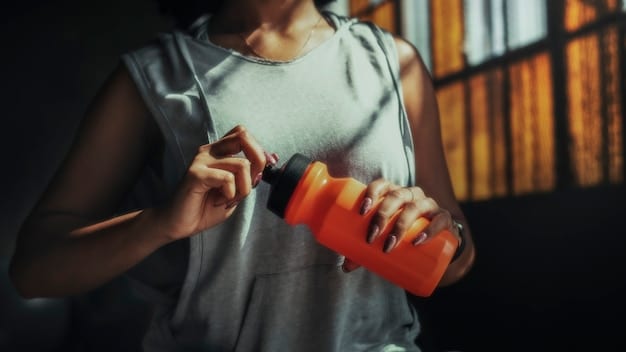
Daily Totals (approx. before fine-tuning): 2150-2500 calories, 190-225g protein, 150-170g fat, 25-38g net carbs. This leaves room for the additional 10-25g of net carbs if strategically used around workouts or for denser vegetable servings to reach the 50g daily limit when needed for performance or variety.
The total net carbs in this plan are intentionally kept below the 50g maximum to allow for individual discretion in adding specific carbohydrate sources based on training intensity. For instance, if an athlete has an exceptionally demanding leg day, they might choose to consume an extra 10-15g of carbs from a sweet potato or a small banana post-workout. This adaptability is crucial for long-term adherence and performance optimization.
Remember, this is a sample. Portions and specific foods should be adjusted based on personal caloric and macronutrient needs, dietary preferences, and training volume. Tracking intake, especially for net carbs, is vital to ensure adherence to the ketogenic parameters while optimizing for bodybuilding goals.
Training Considerations on a Ketogenic Diet
Embarking on a ketogenic diet for bodybuilding goes beyond merely manipulating food. It necessitates a strategic adaptation of training protocols to align with the body’s altered fuel availability. While the initial phase of keto-adaptation might require a temporary reduction in intensity, a properly keto-adapted bodybuilder can maintain, and often even enhance, performance in many aspects of training.
The primary concern for bodybuilders is typically high-intensity, glycolytic work, such as heavy resistance training, which relies heavily on muscle glycogen. When carbohydrate intake is restricted to 50 grams or less, glycogen stores will be significantly lower, potentially impacting strength and power output in the short term. However, the body is remarkably adaptive.
Adapting Resistance Training and Cardio
During the initial weeks of keto-adaptation, a bodybuilder might experience a dip in strength and endurance. It is crucial not to overtrain during this period. Focus on maintaining intensity rather than pushing for new personal bests. As the body becomes more efficient at utilizing fat and ketones for fuel, strength levels typically return, and some athletes report improved stamina during prolonged workouts.
- Resistance Training: While low reps with very heavy weights might feel more challenging initially, focusing on moderate rep ranges (8-12 reps) and mind-muscle connection can be effective. Consider incorporating longer rest periods between sets to allow for recovery and ATP regeneration.
- Cardio: Low to moderate intensity cardio (LISS) is highly effective on a ketogenic diet for fat burning. HIIT (High-Intensity Interval Training) can still be incorporated, especially if carbohydrates are strategically consumed pre-workout (as in a targeted ketogenic diet), but it might feel more demanding without readily available glucose.
- Recovery: Emphasize active recovery, adequate sleep, and consistent electrolyte intake. Hydration is non-negotiable.
The psychological aspect of training on keto is also significant. Some bodybuilders report enhanced focus and stable energy levels without the typical blood sugar crashes associated with carb-heavy diets. This can contribute to more consistent and productive training sessions over time.
Furthermore, the increased reliance on fat for fuel can be advantageous for extended training sessions or multiple daily workouts, as fat stores are virtually limitless compared to glycogen. This can lead to a more sustained energy output even as workout duration increases.
Ultimately, training on a ketogenic diet requires patience and a willingness to listen to one’s body. Adjustments to volume, intensity, and recovery strategies are often necessary. With proper adaptation and nutritional support, bodybuilders can continue to make progress, leveraging ketosis for body composition benefits while maintaining performance.
Potential Benefits and Challenges of Keto Bodybuilding
The adoption of a ketogenic diet for bodybuilding is a nuanced decision, presenting a distinct set of advantages and hurdles. For prospective athletes considering this path, a balanced understanding of these pros and cons is essential to setting realistic expectations and navigating the journey effectively. This nutritional strategy, while potent for some, is not without its specific demands.
One of the most compelling benefits touted by proponents of keto bodybuilding is accelerated fat loss. By dramatically reducing carbohydrate intake, the body is compelled to tap into its fat reserves for energy. This often leads to a more shredded physique, a primary goal for competitive bodybuilders, while potentially preserving lean muscle mass through adequate protein intake.
Advantages of Keto for Bodybuilding
- Enhanced Fat Loss: The primary advantage is the body’s heightened ability to burn fat for fuel, leading to significant reductions in body fat, which is crucial for achieving stage-ready leanness.
- Stable Energy Levels: Many individuals report more consistent energy throughout the day, avoiding the blood sugar spikes and crashes often associated with high-carb diets. This can translate to sustained focus during workouts and reduced post-meal fatigue.
- Appetite Regulation: The high fat and moderate protein content of ketogenic meals can promote greater satiety, reducing cravings and making adherence to a calorie-controlled diet easier.
- Metabolic Flexibility: Over time, the body becomes highly adaptable at switching between fat and glucose for fuel, a valuable skill for endurance and overall metabolic health.
Despite these promising benefits, keto bodybuilding is not without its significant challenges. The restrictive nature of the diet, coupled with the body’s demanding needs during intense training, requires stringent adherence and careful planning. The initial adaptation period can be particularly tough, both physically and mentally.
Drawbacks and Considerations
- Keto Flu: The transition phase often involves lethargy, headaches, irritability, and muscle cramps due to electrolyte imbalances as the body adjusts to burning fat and releasing water.
- Performance Dip (Initial): High-intensity, short-burst activities (like heavy lifting for low reps) may suffer initially due to depleted glycogen stores, which are crucial for rapid ATP regeneration. This requires patience and adaptation.
- Dietary Restriction & Social Challenges: Limiting carbohydrates to 50 grams or less means careful meal planning and navigating social situations where carb-rich foods are prevalent.
- Nutrient Deficiencies: Without careful planning, eliminating major food groups can lead to deficiencies in certain vitamins, minerals, and fiber. Supplementation often becomes necessary.
- Individual Variability: Not everyone responds to a ketogenic diet in the same way. Some individuals may thrive, while others struggle with energy levels or adherence.
Ultimately, a ketogenic diet for bodybuilding requires a significant commitment. It demands discipline in food choices, meticulous tracking, and an understanding of how to mitigate the initial challenges. For those who successfully navigate these hurdles, the potential for achieving an extremely lean physique while maintaining muscle mass can be a powerful motivator.
| Key Point | Brief Description |
|---|---|
| 🔬 Metabolic Shift & Fuel | Keto changes body’s fuel from glucose to fat/ketones, aiding fat loss. |
| 📈 50g Carb Strategy | Allows targeted carb intake pre/post-workout for performance boost. |
| 💪 Protein Intake | Crucial for muscle preservation, aim for 0.8-1.2g per lb lean body mass. |
| ⚠️ Challenges & Benefits | Benefits include fat loss and stable energy; challenges include keto flu and dietary restrictions. |
Frequently Asked Questions About Keto Bodybuilding
▼
While some initial muscle glycogen depletion might occur, a properly structured ketogenic diet with adequate protein intake (0.8-1.2g per pound of lean body mass) can effectively preserve muscle mass. The body’s efficiency in using fat for fuel and ketone bodies as an alternative energy source helps spare protein from being catabolized for glucose, ensuring muscle retention even during intense training.
▼
The initial phase of nutritional ketosis, often accompanied by “keto flu” symptoms, typically lasts a few days to a week. However, full keto-adaptation, where the body efficiently utilizes fat and ketones for high-intensity exercise, can take anywhere from 2 to 4 weeks, and sometimes even longer for athletes as their metabolic pathways fully adjust over time. Consistency is key.
▼
Yes, it’s possible to build muscle on a ketogenic diet. While it may require careful attention to calorie intake and strategic timing of the 50 grams of carbohydrates, muscle protein synthesis can still occur effectively. Many bodybuilders report successful lean mass gains, although progress might be slower than on traditional high-carb bulking diets due to lower glycogen stores impacting peak power output.
▼
For a 50-gram carb limit, focus on nutrient-dense, low-glycemic sources. Berries, leafy greens (like spinach and kale), cruciferous vegetables (broccoli, cauliflower), and small portions of specific starchy vegetables (e.g., sweet potato in moderation) are excellent choices. Simple sugars and refined grains should be strictly avoided to maintain ketosis and optimize nutrient intake.
▼
Yes, electrolyte supplementation is highly recommended, especially during the initial adaptation phase and for active bodybuilders. The diuretic effect of a ketogenic diet causes increased excretion of sodium, potassium, and magnesium. Replenishing these through sources like bone broth, avocado, leafy greens, and targeted supplements can prevent “keto flu” symptoms and support optimal muscle function. Always consult a healthcare professional before starting any new supplement regimen.
Conclusion
The journey to achieving a formidable physique through Keto Bodybuilding Nutrition: Is It Possible? A Sample Plan with 50 Grams of Carbs is undeniably challenging yet holds significant promise for those seeking extreme leanness combined with muscle preservation. While it demands meticulous planning, unwavering adherence, and a deep understanding of one’s own metabolic responses, the ability to leverage fat for fuel offers distinct advantages in body recomposition and sustained energy. This targeted approach, allowing for strategic carbohydrate utilization around training, bridges the gap between strict ketosis and the demanding energy needs of competitive bodybuilding. Ultimately, success lies in patient adaptation, consistent monitoring, and a commitment to refining the balance between macro intake and training intensity to unlock the full potential of this unique dietary strategy.
